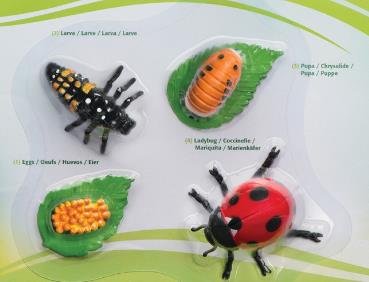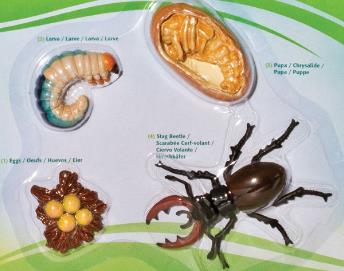
LESSON 3 - COMPARING BEETLE CHARACTERISTICS AND INVESTIGATE WHY NATIVE CALIFORNIA LADYBUGS ARE DISAPPEARINGVS.
OBJECTIVES:
- Comparing beetles with true bugs.
- Observing stages of ladybeetles
VOCABULARY:
- Elytra
- Forewings
- Hindwings
MATERIALS:
- Life cycle models of ladybeetles and stag beetles
- Plastic models of
- worksheet beetle match
- http://www.lostladybug.org
- Powerpoint beetles vs. truebugs
BACKGROUND:
The main distinguishing characteristic of the Coleoptera (sheath-winged) is the
hardened forewings (elytra) six legs and antennae. In some cases the forewings are reduced. The “sheath" refers to the elytra which forms a protective covering over the membranous hindwings and the relatively soft dorsal abdominal wall.
All beetles have complete metamorphoses, i.e. egg-larva (several instars)-pupa- adult. It is that feature, complete metamorphosis, in combination with the elytra which characterizes insects of the order Coleoptera.
In addition to providing food for amphibians, reptiles, fishes, birds and mammals, a role which they share with most other insects, beetles play other important roles in the environment. Some beetles are pollinators, decomposers; some feed on dung; some feed on other invertebrates, some beetles are parasites, and some eat fungi. Some beetles control organisms that ruin human crops like ladybugs, and other beetles like the weevil destroy crops (cotton).
PROCEDURE:
- Tell students that bugs and beetles are often very confusing since there are so many types and we often give them wrong names. For instance ladybugs are actually a type of beetle. Plus, the word “bug” is often used to mean any type of insect. However, there is an official category called “true bugs”. We are going to go over some of the key points that distinguish true bugs and beetles.
- Go over powerpoint comparing beetles and truebugs. Note just how many types of beetles and bugs there are! Emphasize that all beetles go through full metamorphism while true bugs go through incomplete/simple. Some of the key visual differentiating characteristics are wings, flying method and mouths and food.
- Show the videos of beetles flying listed in the last slide of the powerpoint. Beetles flying https://www.youtube.com/watch?v=S77SYgOZXfg ladybug in super slo mo (start at second 20)
- Compare the life cycle models of the ladybeetle and stag beetle which are quite distinct. Beetles go through complete metamorphism and the different stages can easily be mistaken for another group. For example, students are used to identifying adult ladybeetles. However, the larva form of the ladybeetle is so different that they usually think is another type of insect.
Life Cycle of Ladybug or ladybeetle

 Eggs: Ladybug eggs are pale yellow and very small. The mother ladybug lays them on the underside of a leaf for protection. As many as 300 ladybug eggs are produced at a single time. They usually hatch in 3-5 days.
Eggs: Ladybug eggs are pale yellow and very small. The mother ladybug lays them on the underside of a leaf for protection. As many as 300 ladybug eggs are produced at a single time. They usually hatch in 3-5 days.
Larva: Once hatched, a ladybug egg becomes a larva. This baby ladybug has a long body with six legs. The larva eats aphids and grows for about 3 weeks until it turns into a pupa.
Pupa: The pupa is the final step before the baby ladybug is fully grown. It is wet and soft, but hardens as it dries. This stage lasts from 3-12 days until the pupa become an adult.
Adult: Adult ladybugs develop bright colors soon after their pupa stage. Ladybugs live from 3-9 months, sleep through the winter and awake in spring. Life Cycle of Stag Beetle Eggs: Female stag beetles carefully prepare the ground by digging into the soil before laying 30-90 eggs near rotting wood, which will provide food once the eggs hatch. It can take about three weeks for the eggs to hatch. Larva: Stag beetle larvae break from their eggs by cutting the shell. They are C shaped and feed on rotting logs near where they hatch. It takes about two to seven years for them to mature, during which time they feed on decaying wood and grow larger. Pupa: Once a larva reaches its full size of 3 inches long it prepares a safe spot deep in the ground for a cocoon. In the cocoon it undergoes metamorphosis. It may leave its cocoon, but it will stay underground until spring before emerging as an adult stag beetle. Adult: After emerging from the ground, adult stag beetles begin seeking a mate since they only live for a few months. Adult male stag beetles are known for their large, impressive jaws, which are used for wrestling other stag beetles over food or territory. Female stag beetles spend mos their time search for a nesting site - If possible get live ladybeetles and milkweed bugs for students to observe. There are frequently milkweed bugs on the milkweed plants. If you can’t find ladybeetles in the garden you can get live ones at hardware stores or on line. Students should particularly try to observe the parts that distinguish the true bugs from the beetles. (NOTE Since lady beetles and milkweed bugs can fly the containers need to stay covered!!!) After observation, the ladybeetles can be released into the garden per instructions. If you can get live insects, you can cut the description of the two types of models short.
- If you have time, you may want to concentration on the Ladybeetle or Ladybug - Across North America ladybeetle species composition is changing. Over the past twenty years native ladybugs that were once very common have become extremely rare. During this same time ladybugs from other parts of the world have greatly increased both their numbers and range. This is happening very quickly and we don’t know how, or why, or what impact it will have on ladybug diversity or the role that ladybugs play in keeping plant-feeding insect populations low. We're asking you to join us in finding out where all the ladybugs have gone so we can try to prevent more native species from becoming so rare.
Ladybug, ladybug, ladybu-u-ug
Ladybug, ladybug, ladybu-u-ug
Let's go find a ladybug
They live in gardens, weeds, and shrubs
There are 5000 species worldwide
The number of spots identifies the kind
Ladybugs are beetles with six legs
Ladybugs can be yellow, orange, pink, brown, black, white, blue or red
Ladybug, ladybug, ladybu-u-ug
Ladybugs have two sets of wings
Antennae help them smell, touch, and taste things
Ladybugs chew from side to side
If it's cold or dark, they might not fly
Ladybugs roll over and play dead
Ladybugs release a chemical that tastes terrible in self-defense
Ladybugs have important jobs
Eating aphids that destroy our crops
We need lots of different kinds
But some species are now hard to find
Ladybugs, they need us to conserve
Ladybugs, we will protect your habitats
and take care of the Earth
Ladybug, ladybug, ladybu-u-ug
Ladybug, ladybug, ladybu-u-ug
Ladybug, ladybug, ladybug-u-u-ug
Ladybugs